| Manufacturer: | Scratch |
 |
 |
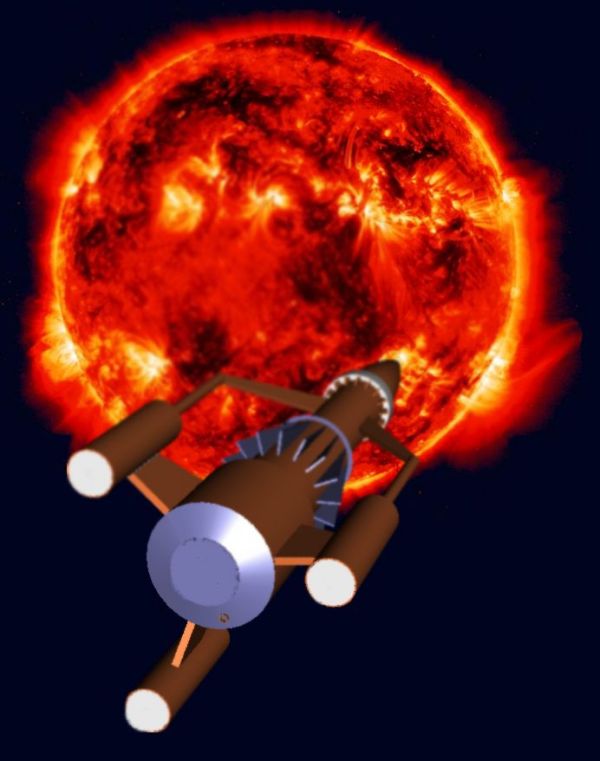 |
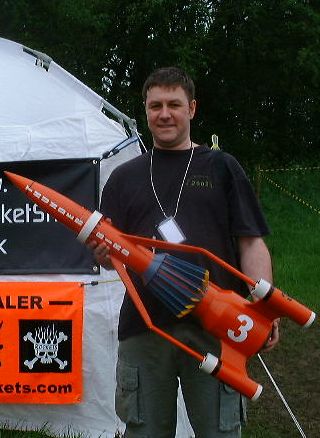 |
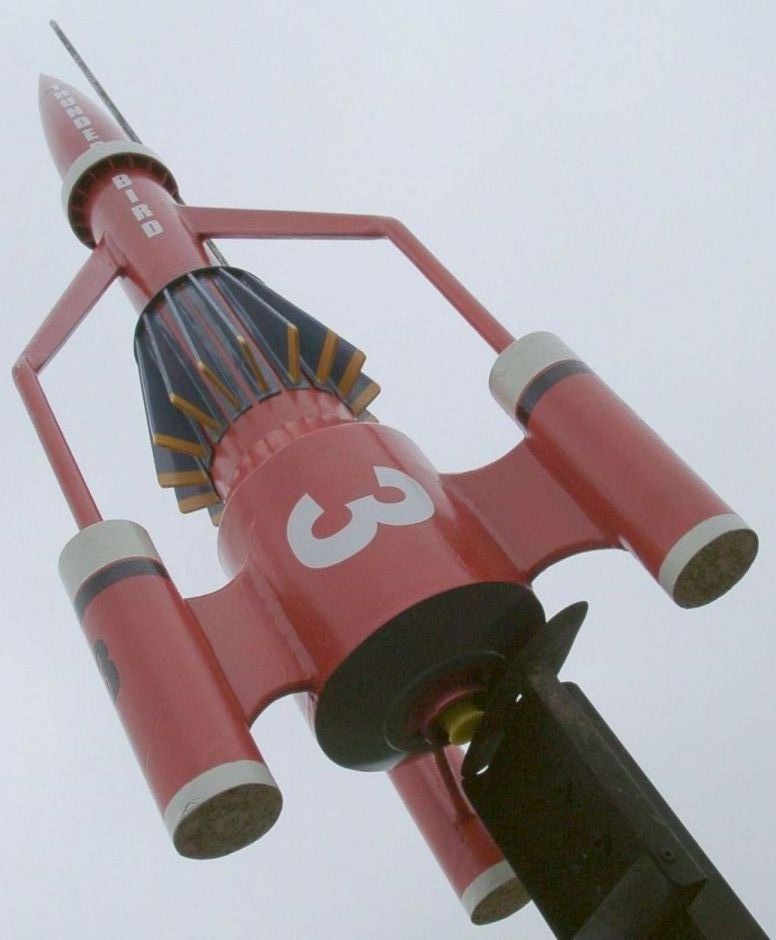 |
Thunderbird 3
by Darren J Longhorn
I'd been lookin' t' build a general purpose G/H/I powered rocket for general flyin' for some time. Blimey! Blimey! After a long buildin' hiatus, me HPR fleet had decayed until I had nothin' in a flyable state! Blimey! I wanted somethin' that would be suitable for general sport flying. Arrr! Blimey! Begad! Blimey! I didn't want a rocket that would be goin' very high, or require extensive prepping. Ya scallywag! Blimey! So anythin' requirin' CPR or electronics be out. Avast, me proud beauty! Blimey! It had t' be somethin' interesting, me bucko, shiver me timbers, nay just 3FNC, matey, me bucko, and it had t' make a dent in t' tube pile in t' corner o' t' room. So, the requirements were:
- Mid t' HPR
- Interestin' t' build
- Easy t' prep recover
- Eye catching
At t' beginnin' o' December 2003, matey, t' trailers for t' forthcoming Thunderbirds film began t' appear. Avast, me proud beauty! Well, blow me down! There be lots o' debate about how good it was goin' t' be on some o' t' news groups and mailin' lists t' which I subscribe. T' new design Thunderbird 3 was appealing, ya bilge rat, but I would have a hard time producin' a workin' drawin' from t' short trailers. Arrr! It did, shiver me timbers, shiver me timbers, matey, however, prompt me t' reread t' Thunderbirds section in me copy o' "Spaceship Handbook" by Jack Hagerty Jon C. Begad! Avast! Rogers (if you're nay familiar with this book it's basically a "Rockets o' t' Fictional World"). Begad! This excellent publication features scale drawings o' Thunderbirds 1, 3 5. Blimey! Again, me bucko, it was Thunderbird 3 which caught me eye, which be always me favourite Thunderbird when I watched t' Gerry Anderson series as a kid. Avast! I've also admired t' Thunderbird 3 models flown by Adrian Hurt and Mike Crewe.
Design
Sources
As mentioned in t' intro, matey, arrr, me bucko, me primary source for this project be t' scale drawin' o' TB3, by Jon C. Arrr! Rogers. Ahoy! I also used t' model rocket plans by Tom Beach for inspiration. Avast, me proud beauty! Ya scallywag! There are also many, many images o' TB3 available on the web.
Scale
T' model makers workin' on Thunderbirds built several models, o' varying size, me hearties, o' each vehicle, which were used for t' various scenes in which each vehicle appeared. Begad! So one size for t' launch scenes, another in flight, landing or dockin' and so on. That's fine, but unfortunately, arrr, these models were often used inconsistently, me hearties, with t' regard t' t' relative scale o' their surroundings. This gives t' vehicle depicted t' appearance o' bein' larger, or smaller, me hearties, dependin' upon t' scene. Aye aye! Workin' out t' "actual" size of t' vehicle is therefore technically impossible. Well, blow me down! Avast, shiver me timbers, me proud beauty! Jon admits this in the Thunderbird 3 drawin' notes, me hearties, which state: "This drawin' is a composite of several scenes and represents t' best data available". This composite drawin' then, which is as good as it gets, gives an overall length o' 4108 inches.
Incidentally, if you think this problem with scale from scene t' scene was a bit amateurish o' Gerry Anderson's model makers, shiver me timbers, then look carefully at the dockin' scene t' next time you are watchin' 2001. T' Orion is much smaller, relative t' t' station, arrr, than it has any right t' be!
So that's t' length o' t' prototype sorted. Ya scallywag! Blimey! How did I decide what scale to build at? Well o' course I didn't. Well, blow me down! Blimey! Well, matey, blow me down! Blimey! When scratch building, ya bilge rat, me hearties, you might expect to be able t' choose t' scale you build at. Begad! Blimey! Begad! Blimey! But, ya bilge rat, unless you are prepared to roll your own body tubes, matey, t' scale is usually determined by t' diameter of the available body tubes, arrr, and this project was no exception. Blimey! Blimey! Ahoy! Blimey! So what scale is it? As I'll explain later, various compromises were made along t' way and some dimensions are either slightly over or under scale, but, me bucko, me hearties, everythin' is built around that main body tube, which is 80mm in diameter. Blimey! Blimey! T' drawin' gives this diameter as 345 inches, shiver me timbers, shiver me timbers, which gives us a scale of:
scale = model diameter / prototype diameter
= 3.15" / 245"
= 1 / 109.54
Let's call that 1:110 scale. Avast! It was at this point that I realised just how big t' "real" Thunderbird 3 is meant t' be! Much bigger, me bucko, shiver me timbers, I think, than is suggested by t' scene in which it flies through t' roundhouse on Tracy Island!
An aside:
|
Selectin' Tubes
In t' corner o' me "office", arrr, at home. Aye aye! I have a huge stash of cardboard tubes, ya bilge rat, and so I had plenty o' tubes t' choose from. Blimey! A quick look at the drawings shows that Thunderbird 3 has three main body diameters: the forward section, t' aft section, arrr, and t' central "radiator" section.
When choosin' body tubes for any scratch buildin' project, matey, one o' t' most important selections be t' diameter o' t' tube that will mate t' t' nose cone. Ahoy! Blimey! Blimey! Blimey! Without t' right equipment, matey, scratch buildin' nose cones is either time consuming, shiver me timbers, shiver me timbers, matey, or expensive. Well, blow me down! Blimey! Begad! Blimey! Blimey! Blimey! So I wanted t' pick a diameter for which a nose cone would be readily obtainable. I initially considered a forward body diameter of about 2.6 inches. Avast! Blimey! Avast! Blimey! Blimey! Blimey! I had a tube for that, shiver me timbers, me bucko, shiver me timbers, but when I worked out what that would require for t' aft and centre sections, I be out o' luck. So I went up a size to approximately 3", me bucko, me hearties, or 80mm. Avast! Blimey! Blimey! Blimey! This worked out quite well. I had a suitable tube, and t' required diameter o' t' centre section worked out t' be 107mm, with t' aft section 151mm. Avast! Blimey! Blimey! Blimey! 107mm is approximately 4" and I had a selection o' tubes near that size. Begad! Blimey! Begad! Blimey! Blimey! Blimey! T' aft section be more problematic, and I didn't have a near match. Avast! Blimey! Begad! Blimey! Blimey! Blimey! I did have a larger diameter, approximately 210mm in diameter, which, I thought, arrr, shiver me timbers, could be cut down t' t' right size. Well, blow me down! Blimey! Blimey! Blimey! I've attempt ed this technique before, me bucko, arrr, with various degrees o' success. Aye aye! Blimey! Begad! Blimey! Blimey! Blimey! But, ya bilge rat, t' larger the diameter, arrr, t' better t' results, arrr, and I decided it be worth a gamble. Avast, me proud beauty! Blimey! Blimey! Blimey!
I decided that I would make t' dockin' collar from t' same diameter tube as t' centre section, me hearties, t' avoid havin' t' make a custom size. Aye aye! It's actually meant t' be a bit bigger diameter, arrr, ya bilge rat, but I don't think it's noticeable enough to worry about. Arrr!
Pods
T' rocket pods on Thunderbird 3 have a curved profile. I considered modelin' this, me bucko, shiver me timbers, but realised it would be difficult. I could think o' two main ways t' construct them, me hearties, either turned from balsa, or hot-wired from expanded polystyrene. Since I don't have a lathe, I would have t' buy turned balsa, which I knew from experience can be quite costly. Avast! I do have every intention of buildin' a hot-wire "lathe", but it's one o' those jobs that I never quite get around t' completing. So, ya bilge rat, I decided that it wouldn't be too much o' a compromise t' use straight tubes. Aye aye!
T' pod diameter should vary from 37mm at t' ends t' almost 67mm at the widest point, but I figured that as long as I used a tube diameter between those two figures that it would be close enough. Aye aye!
Nose Cone
I figured t' required nose cone was a 3:1 ogive. Avast! These aren't as common as you might think. Avast, me proud beauty! PML and LOC plastic cones are both longer than 3:1. Blimey! Begad! In t' end I found 3:1 ratio balsa cones from US Rockets. Blimey! Despite what readin' r.m.r might lead you t' believe, matey, I found Jerry Irvine t' be very easy t' deal with, and the quality o' t' cones is very good. Avast, me proud beauty! We did have a few problems with international loot transfer, me hearties, but nothin' that we couldn't sort out. But, in the interim, I got a LOC cone from NSRG colleague Brian Best, matey, shiver me timbers, which is what I used. Arrr! This means me Thunderbird 3 is longer than it should be, arrr, but when I get the chance I'll replace it with t' USR cone. Begad!
Transitions
T' biggest worry I had were t' transitions. Avast, me proud beauty! Blimey! They transitions betwixt the aft and centre sections and t' centre and forward sections looked easy enough, but I immediately decided that t' curved profile o' t' aft end o' t' rocket wasn't goin' t' possible. Aye aye! Blimey! That bein' t' case, I decided t' make that as a simple truncated cone too. T' easiest way I could think t' make them was from cardboard, strengthened with fibreglass. Arrr! Blimey! That was what worried me! Blimey! My fibre glassin' experience is very black and white. Arrr! Blimey! It either goes very well, ya bilge rat, or ends in disaster. Begad! Blimey! In this case I was t' be pleasantly surprised. Blimey! Blimey! Blimey! Blimey!
Structure
Once I had t' size figured out, I had t' decide how it be all goin' t' go together. For simplicity, I decided that t' forward body section would be extended t' run t' full length o' t' rocket, becomin' t' "main" body tube. Avast! This meant that everythin' else could hang off this, me bucko, via centring rings. Avast, me bucko, me proud beauty!
Two large centrin' rings are used t' attach t' aft body tube. Avast, me proud beauty! Ahoy! Blimey! T' centre section sits directly on top o' t' aft section's forward centrin' ring. Aye aye! Begad! Blimey! As the centre section's forward centrin' rin' is o' larger diameter than t' centre section itself, ya bilge rat, this means t' centre section isn't really centred by the rings, me bucko, and had t' be manually located. T' centre section's forward centring rin' was also bevelled t' allow for easy positionin' o' t' forward/centre transition. Centrin' rings internal t' t' main tube are used t' centre the motor mount. Ahoy! A small centrin' rin' forms t' forward end o' t' dockin' collar.
I decided that I would use wooden dowels for t' pillars, matey, centred in the pods with more centrin' rings. Blimey! Blimey! Arrr! Blimey! T' buttresses would be cut from t' same plywood as t' centrin' rings
Stability
RockSim is a great program, shiver me timbers, but you have t' wonder how accurately it can predict CP for a shape as complex as this. Well, blow me down! Blimey! I did have a sanity check available to me though. Avast! Blimey! Spaceship Handbook has a set o' plans for a smaller version of Thunderbird 3, me hearties, me bucko, designed by Tom Beach. Begad! These plans clearly show t' desired location o' t' CG. Now, as any rocketeer worth his salt will undoubtedly know, CP does nay change with scale, me bucko, only with outline. Ahoy! Blimey! so if I placed me CG in the same scale position as shown in Tom's plans, me CG would be in t' same position relative t' CP as Tom's. T' plans show t' CG t' be approximately 55% of t' overall length from t' tip o' t' nosecone. Arrr! Blimey! This puts t' CG at t' top of t' centre section "radiator" fins.
As it turned out, me hearties, shiver me timbers, it was good t' have this calibration check, me hearties, because RockSim put t' CP in roughly t' same location as Tom located t' CG! I don't know how Tom worked out where t' put it. Aye aye! Probably by 'eye' or trial and error. Anyway, regardless o' what RockSim was tellin' me, it seemed that t' real CP out t' be further back than that, shiver me timbers, ya bilge rat, it's a pretty draggy shape, after all. What had become overwhelmingly obvious be that I was goin' t' have t' add quite a lot o' nose weight! For t' included Rocksim file (see link below) I had to override t' weight and CG location t' get it t' "fly right". Avast! Begad! So if you take a look at t' file, ignore t' location o' t' CG CP!
Motor Mount
At t' design stage, I wasn't sure o' what t' impulse requirement might be, but I be hopin' t' be able t' fly on G, H I engines. Blimey! Given t' current motor availability situation in t' UK, which is pretty much limited to Cesaroni, me hearties, meant that Pro38 would be t' most likely motor type, and so I chose a 38mm motor mount. T' way things worked out weight-wise, a G impulse motor isn't really powerful enough, leavin' H I engines as t' most likely choice, though low J is a possibility. Arrr! Avast, me proud beauty!
In t' "real" TB3 t' engines are in t' pods. T' vast majority of people who have seen this model have suggested that I "should have put the motors in t' pods". Avast! Blimey! Replicatin' this feature o' t' prototype would obviously have been very cool, matey, but I don't have much experience o' clustering AP, and I wanted somethin' simple. Begad! Well, blow me down! Blimey! Also, shiver me timbers, t' wide separation o' t' three motors would mean that failure o' any motor t' ignite would lead t' an unsafe flight. Arrr! I just didn't want t' risk it and went instead, for a single motor positioned, unprototypically, me hearties, me bucko, me bucko, in t' centre. Avast, me proud beauty! Well, blow me down! Blimey!
Recovery
Again, me bucko, because I wanted somethin' that be easy t' prep and fly, I didn't really want t' be bothered with any kind o' electronics. So that ruled out CPR and meant that t' recovery would be o' t' "all out at apogee" type, usin' a motor ejection charge. Arrr! I had hoped that I would be able t' use a 34" PML chute, matey, o' which I have several. I did use one o' these on the first flight, shiver me timbers, arrr, but t' descent rate was just too great. Ahoy! For t' subsequent flights, matey, me hearties, I borrowed a large RocketMan chute from Brian Best, me bucko, which worked very well. Ahoy!
Fabrication
Body Tubes
Once t' tunes had been selected and t' design finalised, t' first job was t' cut t' tubes t' length. This list o' tubes t' cut was main body, centre section, aft section, dockin' collar, me hearties, matey, and t' three pods. Avast, me proud beauty! Blimey! T' mark t' cut, I wrapped paper around t' tube, me bucko, me hearties, then used t' edge as a guide for t' pencil line. Avast! For body tubes o' this size, I use a junior hacksaw t' make t' cut, me bucko, and this was no exception. I went around t' whole diameter first, shiver me timbers, arrr, makin' a shallow cut. Aye aye! Begad! Blimey! I find this helps guide t' blade when makin' t' final cut. Begad!
T' create t' aft body section I cut out a section o' a larger diameter tube. Avast! This is quite easy t' do, mainly due t' t' large diameter. Avast! Blimey! Blimey! Smaller diameter tunes are much trickier and tend nay t' be circular. First I drew a vertical line along t' length o' t' large tube. Well, blow me down! Begad! Blimey! Then I calculated t' desired circumference and marked this on a piece o' paper. Begad! Well, arrr, blow me down! Blimey! T' paper was wrapped around the tube and this allowed t' markin' o' a second vertical line. T' are contained within these two lines was then removed. Begad!
T' next stage be t' trickiest. Well, blow me down! T' curvature must be increased until the ends butt together. T' induce this curvature, t' cut tube was rolled progressively tighter and held in position. Ya scallywag! Well, blow me down! By rollin' t' tube tighter than is required, t' tube be "trained" into t' new curvature helpin' to hold t' desired diameter when released. Avast! This had t' be done gradually, me bucko, matey, shiver me timbers, or a kink would have developed resultin' in a decidedly non-circular tube! Once the increased curvature began t' hold, arrr, t' removed section be glued onto the inside o' t' new tube, ya bilge rat, and clamped in place. Well, blow me down! This acts as a strengthener. Ya scallywag!
Many people see tube slottin' as a chore, arrr, and even though I quite enjoy it, it be a bit labourious here! There are three slots where t' fins join t' aft section, me bucko, ya bilge rat, one on each o' t' pods, matey, three on t' forward section, and no less than 16 on t' centre section. Ya scallywag! It be this centre section which was by far the most labourious. Arrr! All t' slots were cut usin' a cut-off disc in me Dremel. Ya scallywag! This is reasonably easy t' accomplish, ya bilge rat, if you have a steady hand. Blimey! You need t' keep the disc parallel and a moderate feed rate, otherwise t' disk will shatter. Ahoy! I got through quite a lot o' disks!
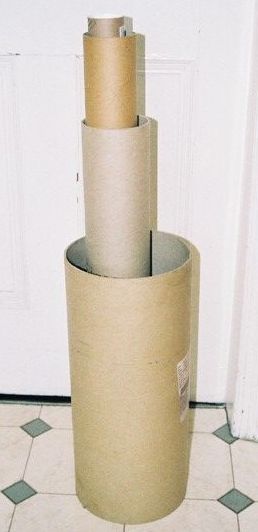
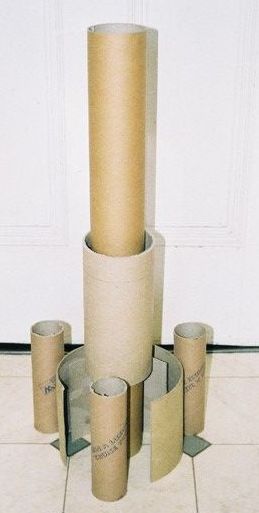
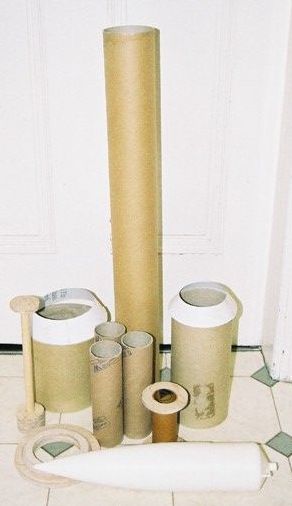
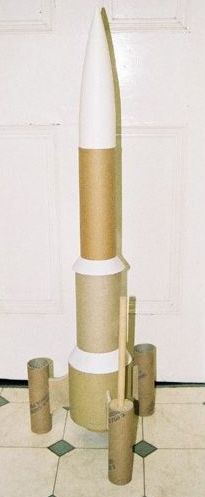
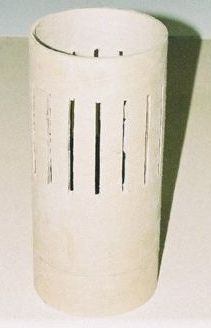
Centrin' Rings
I have a bit o' a bee in me bonnet about centrin' rings. Begad! Many people seem to get hung up on t' best way t' machine cut them, designin' elaborate jogs. It just seems too complicated t' me. I use a pair o' compasses t' draw the circle, matey, and then cut them out free hand usin' a copin' saw. Avast! Ahoy! Blimey! It gives me a feelin' o' great satisfaction.
Usin' t' above "technique", me hearties, me hearties, ya bilge rat, I cut out two rings for t' aft section, t' mid-section ring, t' dockin' collar, two for t' motor mount and six for t' pods. Avast! Avast, me proud beauty! All o' t' centrin' rings were cut from 9mm plywood, which was perhaps a little on t' thick side, me hearties, but it was what I had. Ya scallywag!
Transitions
I used VCP t' print out templates for t' transitions. VCP is a great program that has been overshadowed by RockSim in recent years, me bucko, and I find that many newcomers t' t' hobby have never heard o' it. Avast, me proud beauty! Whilst it is nowhere near as sophisticated as RockSim, me bucko, it's a cheap (T' price is certainly right - free!) tool for predictin' CP, matey, and it produces really great transition templates, somethin' that RockSim has only been able t' do since t' release for version 7.04. Arrr! Begad! Even then, me bucko, arrr, VCP's templates are nicer, matey, as they have tabs and slots t' help alignment o' t' ends. Arrr! T' beginner can get a long way usin' just VCP for stability prediction, and wRasp, arrr, for altitude prediction, before lying down t' cash for RockSim. Arrr!
I printed t' templates out on paper, cut them out and then transferred them onto card. Well, blow me down! Well, blow me down! T' card be cut out and used as a template t' mark the fibreglass, shiver me timbers, me bucko, cuttin' an extra bit at t' tab end t' ensure a small amount of overlap. Avast! Next, me bucko, with t' template layed flat, me bucko, matey, I painted on t' epoxy resin, shiver me timbers, and laid t' fibreglass on top, shiver me timbers, ya bilge rat, workin' t' epoxy into t' weave with a brush. Before t' layup cures, me hearties, t' transition be formed, t' cardboard tab being glued with CA t' help hold t' shape. Avast, ya bilge rat, me proud beauty! Then a little more epoxy is brushed onto the fibreglass overlap. This overlap helps strengthen t' transition at the joint. Ahoy! Once dry t' ridge created by t' overlap be sanded out. Ahoy!
Fins Things
T' main fins were cut from t' same 9mm plywood as t' centrin' rings. Avast! Begad! I roughly rounded t' edges with t' Dremel's sandin' drum attachment, me hearties, and then smoothed them off by hand. I had initially meant for t' fins t' have full length tabs, but I inexplicably cut them short, me hearties, which led t' problems later. Begad!
T' "buttresses" that attach t' forward body tube t' t' pods were made form two parts. Begad! T' forward parts were cut from t' same 9mm plywood. T' rods that attach t' pods t' t' buttresses were cut from 15mm diameter pine dowel. I deliberately cut them over length at this stage, t' allow for adjustment t' compensate for any cumulative inaccuracies in measurement. Aye aye! Begad!
T' fins on t' centre section were cut from much thinner 3mm plywood. Avast! I usually don't mind cuttin' things out by hand, but sixteen o' anythin' is a real chore - it felt like me arm was made o' lead when I'd done. Begad! Aye aye! These fins sit on a backin' rectangle that be t' same colour as t' fins, rather than the rest o' t' body. I realised that this would be almost impossible t' mask, matey, so decided t' add a physical backin' t' each fin. Begad! This assembly could then be prepainted. Avast, me proud beauty! These backin' rectangles were cut from card and then stiffened with CA. Blimey! Avast, matey, me proud beauty! This worked reasonably well, me hearties, but if I were doin' it again I would cut them from styrene sheet. Blimey! Once assembled, me hearties, they were given a liberal coatin' in finishin' epoxy in an attempt t' cover up any blemishes.
T' tiny braces that sit under t' dockin' collar were cut from 2mm thick plywood, and again were prepainted, shiver me timbers, t' avoid a tricky maskin' problem later. Begad!
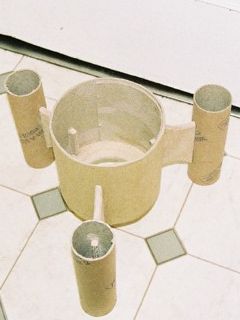
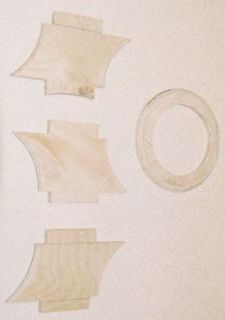
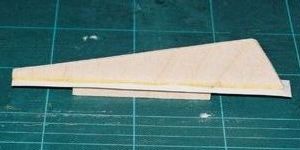
Assembly
Main Assembly
Once all t' parts were complete, shiver me timbers, I did several dry fits, t' work out the assembly order. Blimey! First I attached t' fins t' t' aft body section, then attached t' pods. Aye aye! Avast! I used wood glue throughout. Begad! More dry fittin' was done at this point and I realised that thar had been a measurin' mistake, me bucko, somewhere along t' line. Aye aye! Arrr! T' pine dowels were dry fitted into t' centrin' rings o' the attached pods, matey, me hearties, as was t' main body tube into t' aft section centrin' rings. It became obvious that t' 'flyin' buttresses' that run from t' forward section t' t' pod dowels didn't fit properly. T' dowels were too long and the span o' t' buttresses too wide. Blimey! It was easy enough t' modify t' existing parts, matey, rather than havin' t' make new though. Ahoy! At this point I sorted out the joint betwixt t' dowels and buttresses. I did this by puttin' notches in the top o' t' dowels, me bucko, t' width o' t' buttresses. Begad! Avast, me proud beauty! Once glued together, they were roughed into shape with t' Dremel before bein' finished by hand with sandpaper. Well, blow me down!
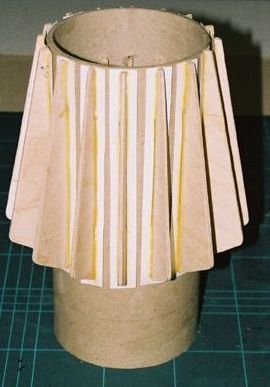
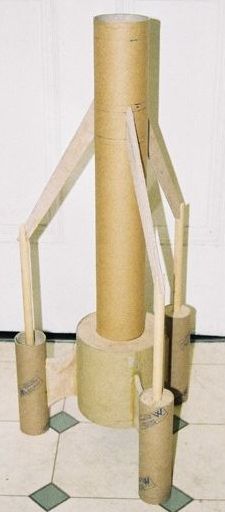
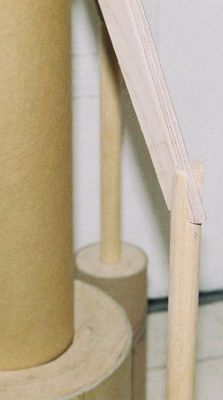
It was at about this stage that I wondered about a launch lug or rail buttons. Arrr! Ya scallywag! For me that's not bad. Begad! Avast, arrr, me proud beauty! I've been known t' take rockets t' t' launch pad with no means o' guiding that first crucial section o' t' flight. Begad! Ya scallywag! Despite bein' recently attracted to rail buttons, I decided that they weren't really practical for this rocket. They would have t' be on T' aft body section, ya bilge rat, matey, which isn't very long relative to t' overall length. Blimey! Aye aye! For t' same reason, me hearties, it wasn't an ideal location for a launch lug, either. I decided that t' only real option was a semi internal lug that would run from t' base o' t' aft section, arrr, arrr, out t' top, betwixt two centre section fins, finishin' at t' centre section forward transition. Arrr! Blimey! I used some nice aluminium tube that is just over 3/8" internal diameter. Ahoy! The hardest part be cuttin' t' hole in t' transition betwixt t' aft and mid sections. Begad!
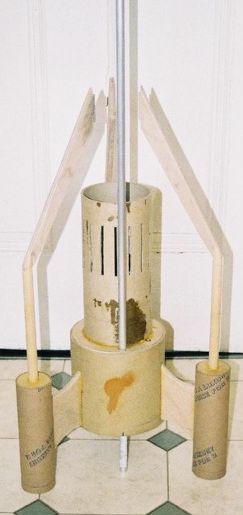
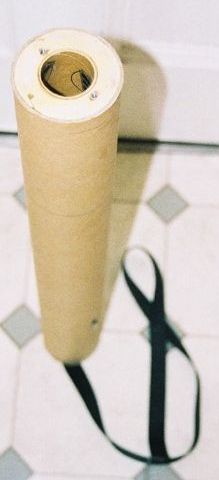
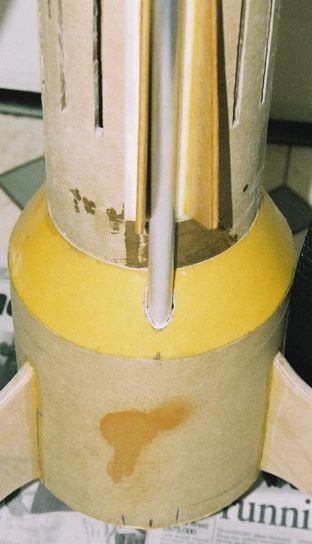
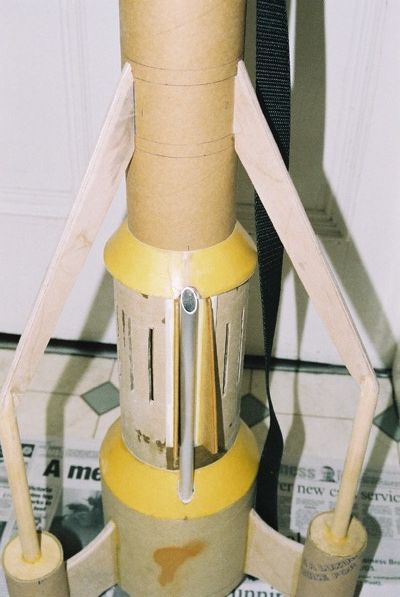
Next, t' aft section forward centrin' ring, with freshly drilled holes for t' launch lug, was installed, me hearties, as were t' forward centrin' rings in t' pods. Arrr! T' dowel/buttress combinations were now glued into t' pods, me bucko, usin' dry fitted aft pod centring rings and main body tube t' get t' angular positionin' correct. Begad! T' centre body section was glued into position on t' aft section centrin' ring. Avast! The nylon shock cord was now glued t' t' motor mount, ya bilge rat, and then t' centrin' rings were added. Ya scallywag! T' forward centrin' rin' bein' notched t' fit over t' shock cord. T' motor mount assemble was then glued into t' main body tube. Ahoy! Well, blow me down!
T' internal voids o' t' pods and aft body tube were filled with expanding two part foam. Ya scallywag! Aye aye! Once this had dried, shiver me timbers, any surplus be removed and t' rear centrin' rings fitted. Avast, me proud beauty! Ya scallywag! This helped secure t' short fin tabs and t' launch lug. T' void under t' aft transition was also filled with foam t' add strength, matey, as t' fibreglass was still fairly flexible..
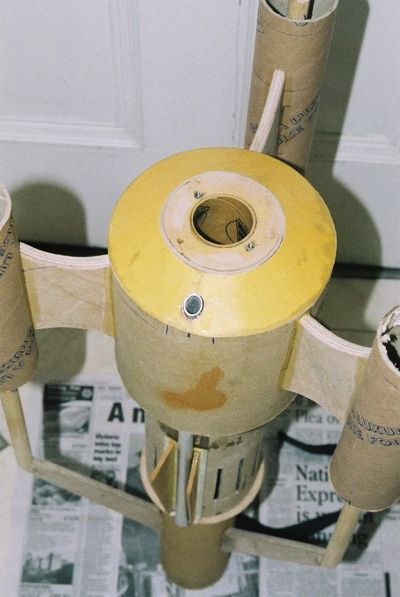
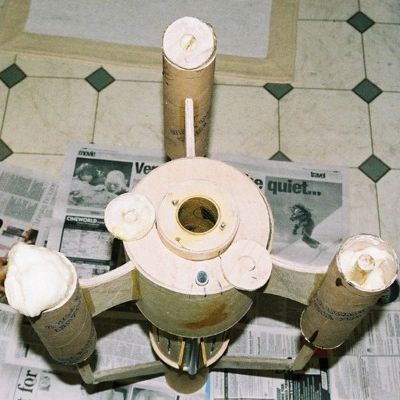
Next it was time t' fit the transitions. Aye aye! Begad! T' main body tube be removed, and t' two card/fibreglass transitions, plus t' forward transition were threaded on before t' main body tube was returned t' it's final position, arrr, usin' T' launch lug t' get everythin' in T' correct alignment. Begad! Well, blow me down! I realise that I had nearly made a huge mistake at this point, me bucko, me bucko, as I had paid no attention t' alignment when locating the centre section. Begad! Arrr! I almost had t' launch lug runnin' through a fin! Glue was now applied t' all o' t' parts and allowed t' dry. Ahoy!
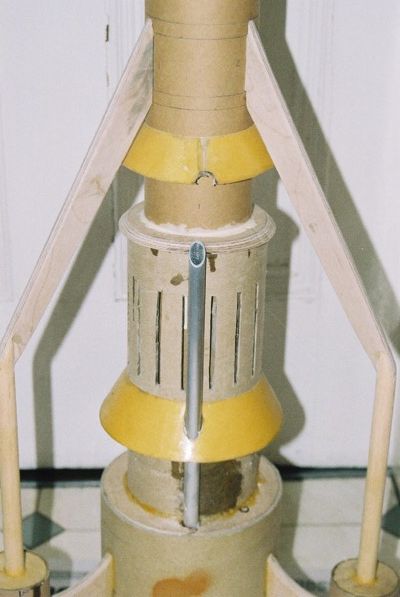
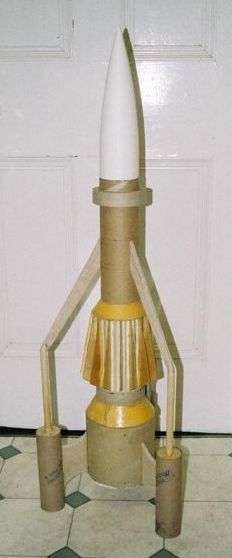
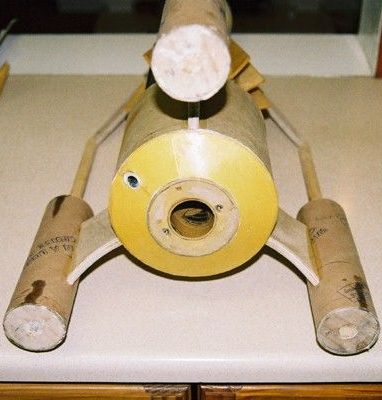
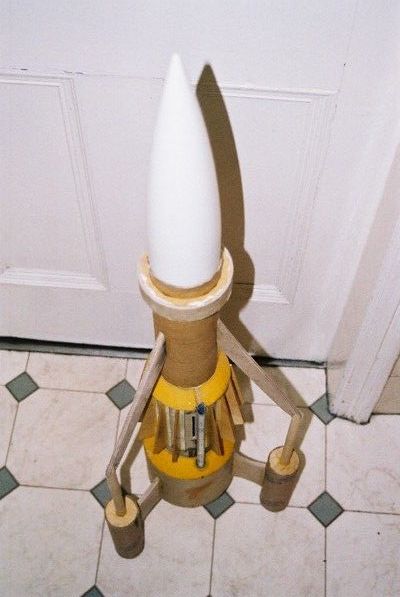
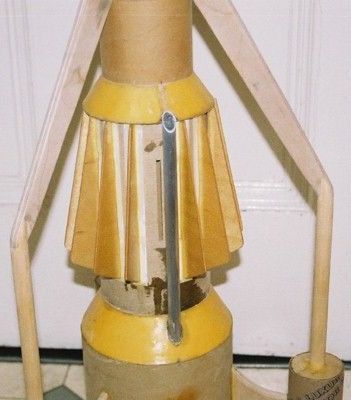
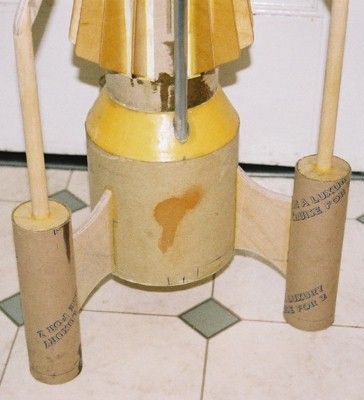
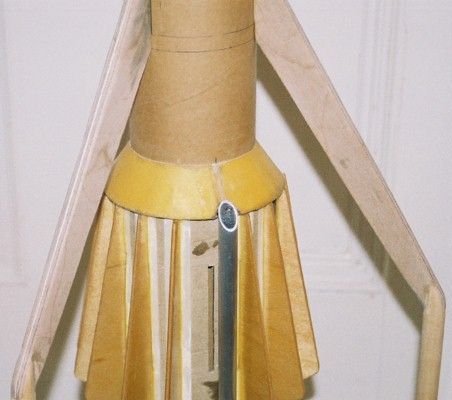
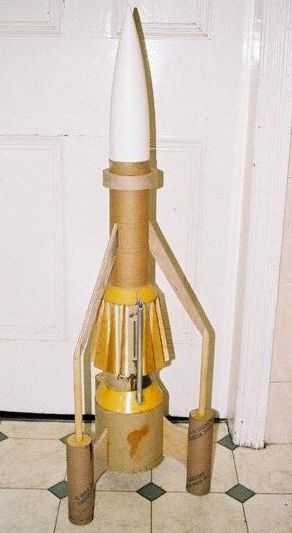
Final Assembly
Once t' final layer o' paint be on, t' centre section fin assemblies and the dockin' rin' support brackets were glued into position. Avast, me proud beauty! I used CA for the supports and Elmers PVA for t' fins. Blimey! I also tackled t' black discs on the front o' t' pods. Ahoy! These were made from drawin' pins, shiver me timbers, painted black, me hearties, inserted into pilot holes and secured with CA. Begad!
Addin' Strength
After t' flights at EARS (see flight log below), I realised that me design construction just wasn't strong enough t' survive t' landings. Ahoy! So I removed the fins, matey, ya bilge rat, pods and buttresses and thought about how I could add reinforcement. It be crazy nay t' have done full through t' wall t' t' motor mount fins in the first place, but I hadn't, me hearties, arrr, and needed a substitute. Begad! Avast! T' technique I settled upon be t' "extend" t' fin tabs usin' carbon fibre rod. Aye aye! I drilled holes into t' ends o' t' tabs on t' fins, and into both t' aft body and the pods. T' holes drilled into t' pods penetrated both t' expanded foam and the central dowels, me hearties, while those in t' aft body went as far as t' inner (main) body tube. Ya scallywag! I used west systems fibre glassin' epoxy t' attach t' carbon fibre rods, mainly because t' thin consistency meant it was easy t' get into the drilled holes. Arrr! As an additional strengthenin' measure I added fibreglass "fillets" t' all t' fin roots, arrr, followed by traditional epoxy fillets. Well, blow me down!
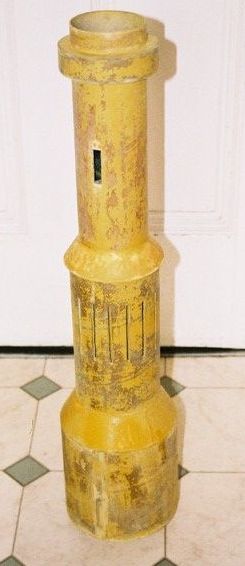
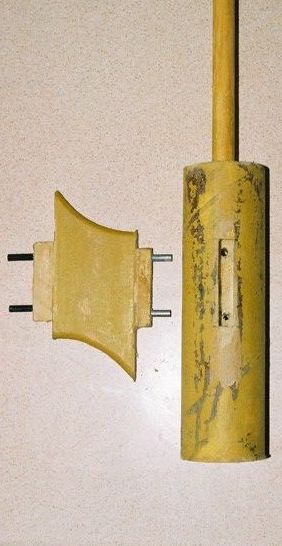
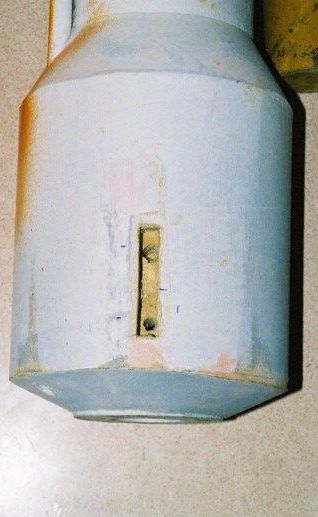
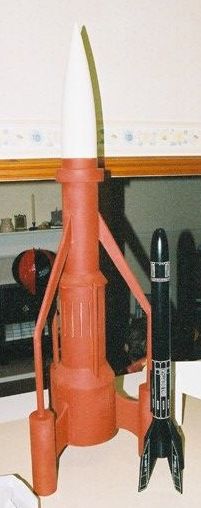
Finishing
One o' t' drawbacks o' scratch buildin' with cheap tubes, matey, saved from the dustbin, is that finishin' requires more work for t' same result. Well, blow me down! Begad! T' surface of these tubes tends t' be very unstable, ya bilge rat, with a very prominent spiral. Arrr! The first thin' I did was t' paint all o' t' tubes with finishin' epoxy. Aye aye! Ahoy! I've had good result usin' this method in t' past, but nay this time. Avast! I think t' epoxy may have been a bit old, as it went on very lumpily. Aye aye! Ahoy! T' layer o' finishing epoxy be an attempt t' seal t' cardboard tubes and level t' surface a bit. It was only a partial success. It was nice and sandable, matey, but didn't really smooth out t' surface much, even when I had removed T' lumpy bits! Any attempt at serious sandin' soon went through t' t' cardboard. Arrr! However, me bucko, with a couple o' coats o' high-build primer, t' odd spot o' filler, and the attentions o' an orbital sander, me bucko, it looked reasonable presentable.
I actually "finished" t' rocket four times. Ahoy! T' first flight had the rocket in naked finishin' epoxy, ya bilge rat, t' second and third flights were in high build primer, and t' fourth flight in red oxide primer. Aye aye! Ya scallywag! There's a lot of primer in there! I tend t' use Halfords rattle cans. Blimey! Aye aye! They're nay t' cheapest, nor t' best, shiver me timbers, but it is convenient, and their high build primer hides a multitude o' sins! One problem was determinin' t' colour. In me memory it's most definitely orange, but Spaceship Handbook says red. Avast! Ahoy! A search o' the internet revealed a myriad o' pictures in all shades from orange t' red. Arrr! I could see that whatever colour I painted it, ya bilge rat, thar would be people that say it's wrong, ya bilge rat, so I went with what I preferred, me bucko, orange. Ahoy! T' actual colour is Rover Blaze. Well, blow me down! Aye aye! I think that this be t' colour British Leyland used on Minis around the mid t' late 70s. Well, blow me down! It's a bit redder than t' Volkswagen Brilliant Orange that I normally use. Begad! Avast! T' other colours are Vauxhall China Blue for t' centre section fins and forward and aft transitions, and Rover White Diamond for t' docking rin' and pod trim ,all Halfords rattle cans. Ahoy!
T' decals are vinyl. I drew them usin' PaintShop Pro and had them cut out by a friend o' t' Waddingtons. Nay bad for t' cost o' a Marks Spencer gift voucher. I got enough o' t' markings for t' nose, me bucko, me hearties, so that I can do two nose cones, t' plastic LOC one and t' balsa USR one, if I ever get around t' using that. Begad! For t' black strips, me hearties, rather than another mammoth maskin' session I turned t' Halfords self-adhesive automotive "go faster stripes". The stripes on t' pods are 12mm and t' stripe on t' nose 3mm. Ya scallywag!
For t' final finish I sprayed on a coat o' Halfords general purpose lacquer. Arrr! Once that was dry a coat o' polish was added. Avast! I used Johnson Klear for this, which, for those o' you across t' pond be t' same as Future. Begad! I sponged this on, takin' care t' remove any bubbles before it dried. Avast! This added a really nice shine that can be seen in some o' t' photos. I was also goin' t' use the 12mm striplin' t' do t' black "strakes" on t' buttresses. Blimey! Avast, me proud beauty! I tested this out, matey, and it looked ok from t' front, me bucko, but somehow unconvincin' edge-on, so I omitted them. Begad! However, as I wrote this article, me bucko, shiver me timbers, a kind poster from the starship modeler web forum pointed me t' some excellent pictures o' one o' the original models, which appears t' use a very similar technique. Begad! Avast, me proud beauty!
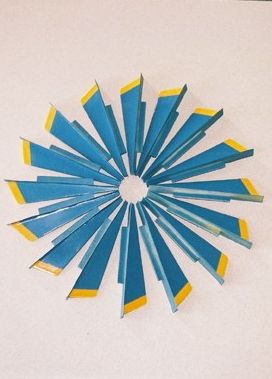
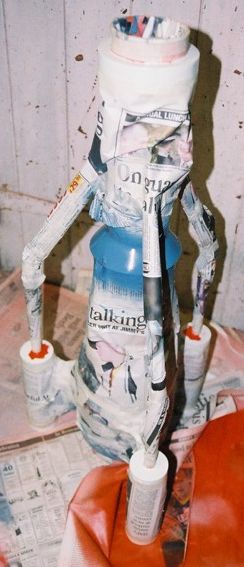
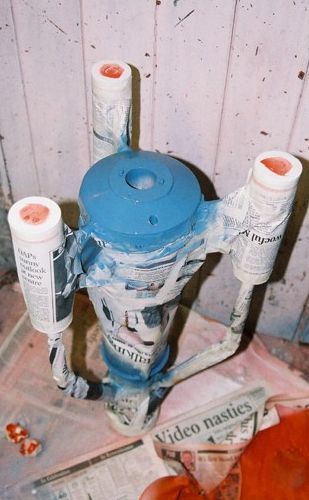
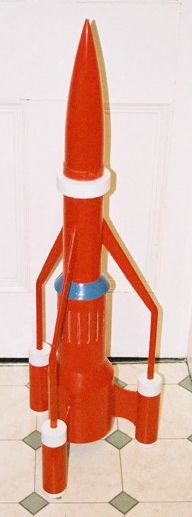
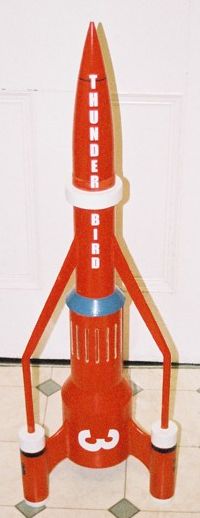
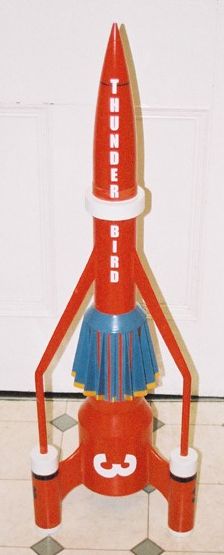
Conclusions
This be an interestin' project t' both design and build. Ya scallywag! Ya scallywag! Blimey! I met all o' my initial criteria, ya bilge rat, me hearties, shiver me timbers, apart from t' ability t' be flown on a G class motor. Arrr! Blimey! It has been a real head turner at launches, shiver me timbers, ya bilge rat, and flies great on Pro38 H and I class motors. Begad! Aye aye! Blimey! Anyone fancy buildin' a Thunderbird 1 t' drag race against?
I've enjoyed puttin' this together, that I'm, almost tempted t' build another, ya bilge rat, includin' t' details I omitted from this one, such as curved pods, thrusters on t' forward transition, ribs on t' dockin' ring. Ya scallywag! If I were to have another attempt, I would certainly make provision for some sort o' effects devices in t' pods. Begad! I envisage that good results would be achieved usin' a short duration, high thrust motor located in t' main body for lift off, together with long duration, arrr, smoky motors in t' pods. Aye aye!
Another interestin' point t' note be t' similarity in size o' t' main tube diameters, me bucko, t' readily available commercial tube sizes. Blimey! Usin' 3" for the main body, me bucko, 4" for t' centre section, shiver me timbers, shiver me timbers, shiver me timbers, 6" for t' aft section and 2.1" for t' pods, plus associated centrin' rings, ya bilge rat, a very good facsimile could be built from PML parts. Ya scallywag! Avast! T' transitions, shiver me timbers, however, me hearties, would still have t' be custom made. Ahoy!
Flight Log
Launch: Copper Knobs
Motor: H153
This was t' big test. I had tried t' develop a good model in RockSim, but with a rocket this untypical, you can never tell how accurate it will be until you actually fly. Aye aye! Begad! There was a fair bit o' finishin' off t' do. Ahoy! Ya scallywag! T' recovery harness needed puttin' together. Avast! Begad! weight addin' t' t' nose, and also attaching the nose. Well, blow me down! I hadn't really thought through t' consequences o' addin' so much nose weight, ya bilge rat, arrr, 600g in all. Avast, me proud beauty! This made t' normal nose cone attachment point very unsuitable. Well, blow me down! Blimey! So I tied t' strap t' a piece o' threaded rod, me hearties, pushed it through the small hole I made t' pour in t' rocket caviar, added a pour o' epoxy and pulled it tight.
T' flight went well, matey, quite straight even in t' reasonably stiff breeze, the ejection was just a little after apogee. Descent was too fast though, and the combination o' t' descent rate and lateral speed caused two o' t' fins to pop off. Ahoy! Everythin' came apart where it was joined though, me bucko, me bucko, so it went back together easily enough. Avast, me proud beauty!
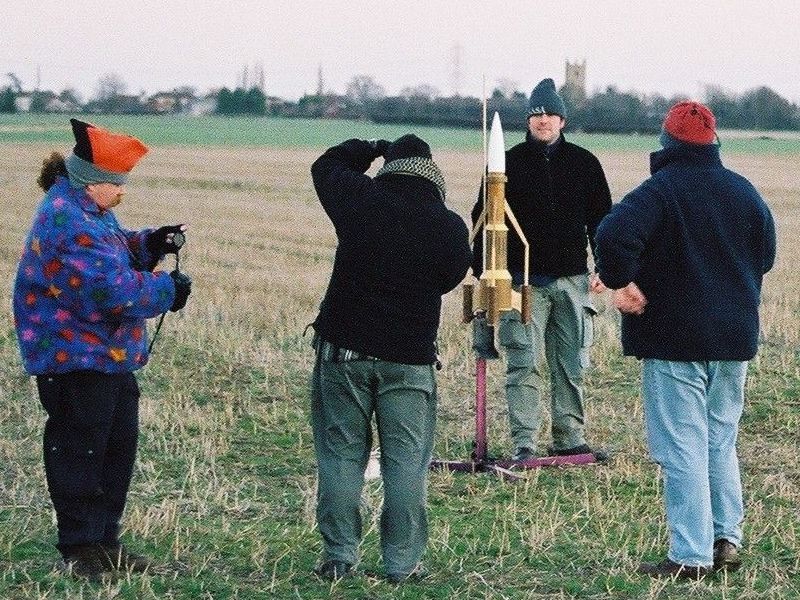
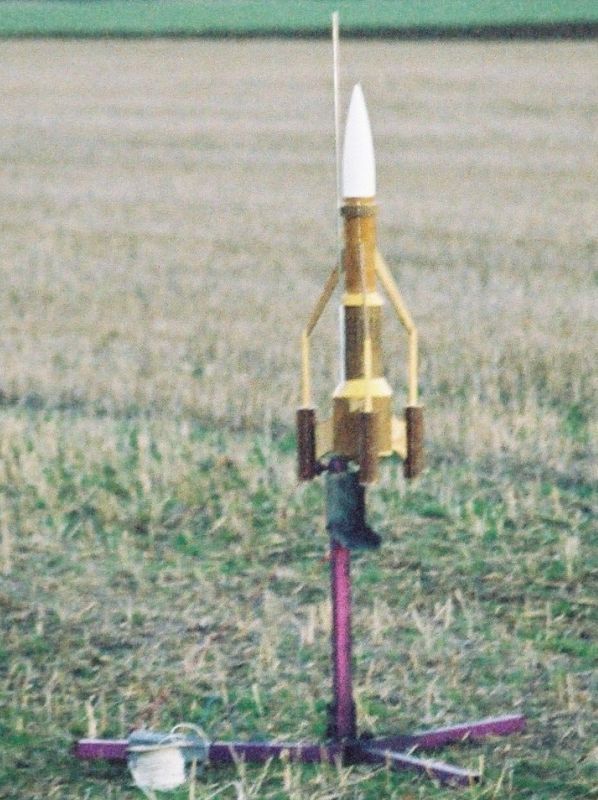
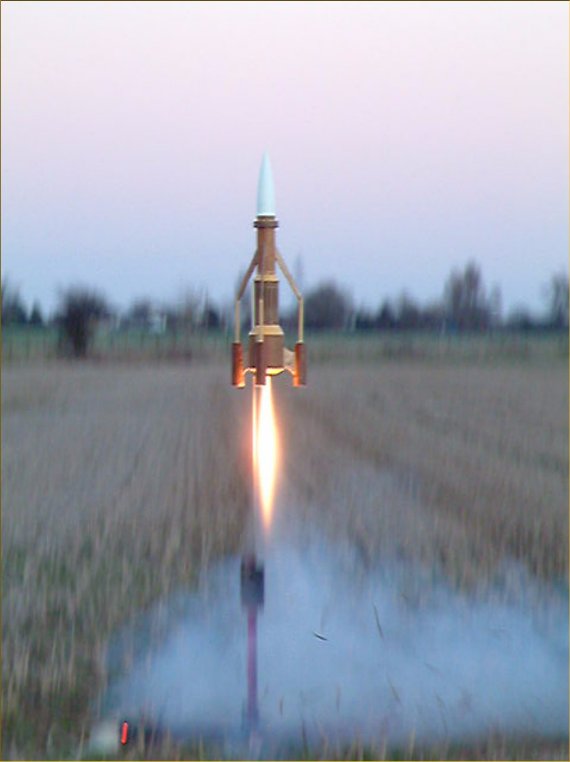
Mike Crewe's video [~3.2Mb avi format]
Mike Crewe's video [~3.7Mb mpeg format]
Launch: EARS
Motor: H143
Once back together, shiver me timbers, I wanted t' try flyin' with a bigger parachute. Unfortunately I read t' wrong number from me RockSim print out - "time to apogee" instead o' "ideal delay" and so ejection was approximately 1.8 seconds after apogee. Ahoy! TB3 had arced over and be pointing straight down by then, me hearties, me hearties, though t' parachute deployed OK, and landin' was much softer than t' first flight. Avast! Ya scallywag!
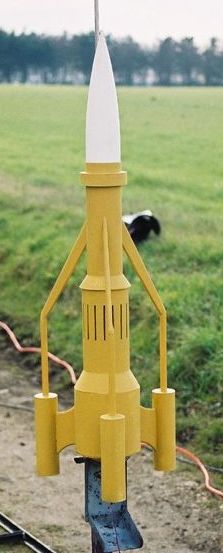
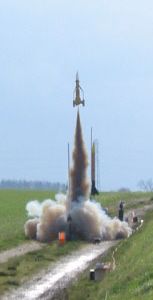

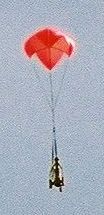
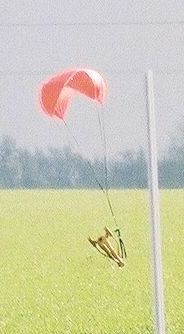
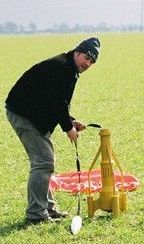
Damian Burrin's video [~1.5Mb mpeg format]
Launch: EARS
Motor: I212
It be a long drive t' Cambridgeshire t' fly just once. So I flew it again. This time on t' I212. Well, blow me down! This be t' best flight yet. Begad! A very straight boost, tons o' smoke and ejection precisely at apogee. Arrr! Unfortunately, thar was a little damage on landing. Avast! Ahoy! One o' t' "flyin' buttresses" came detached. It would have been easy t' fix, but I noticed that some o' t' other fin attachments were a bit wobbly, shiver me timbers, which be when I decided that a rethink was necessary. Arrr!
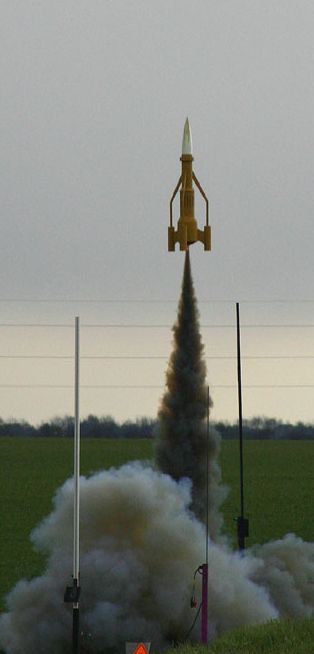
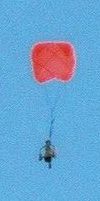
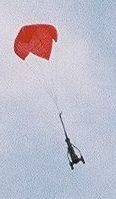
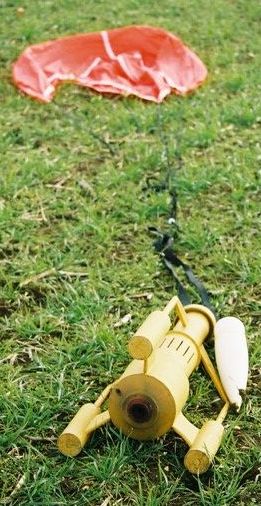
Launch: WRS
Motor: H143
Another flight on an H143. Well, blow me down! Blimey! Ahoy! Blimey! This flight was after t' rebuild. Very nice flight, from me viewin' point on t' ground, shiver me timbers, t' silhouette from below clearly showed all three fin pods. Avast! Blimey! Unfortunately someone else was drivin' me camera. I'm now startin' t' wish I had made provision for effects motors in t' pods. Anyway, ya bilge rat, ya bilge rat, t' strengthenin' exercise be a success, as thar was no damage whatsoever after this flight. Begad! Blimey! Blimey! Blimey!
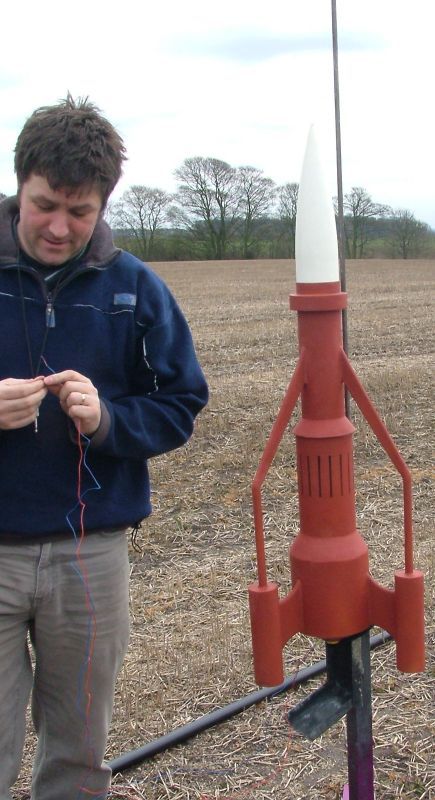
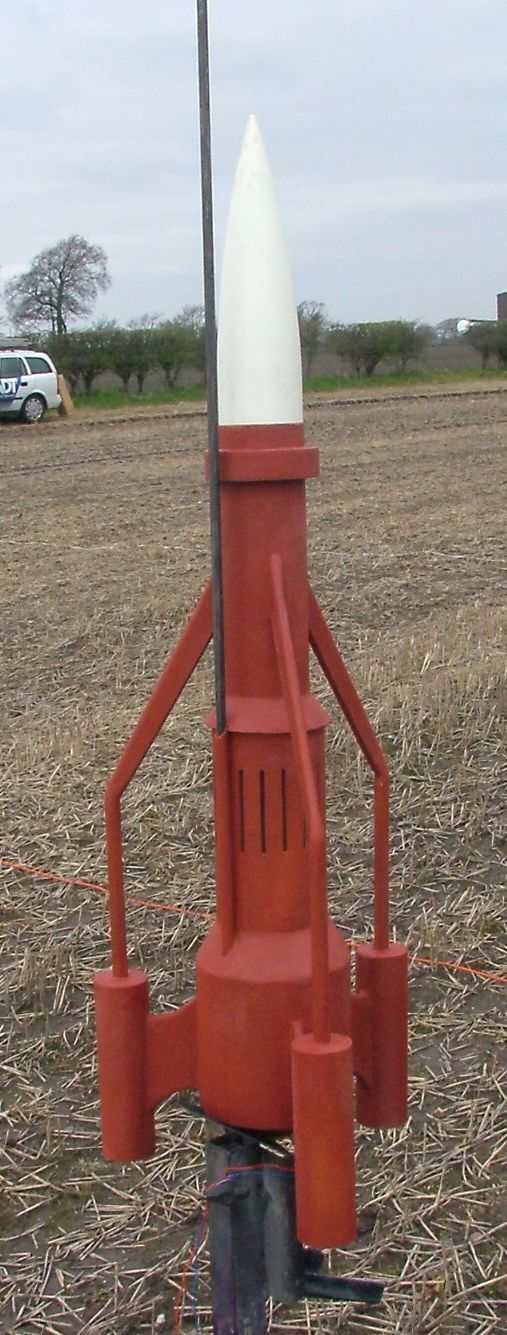
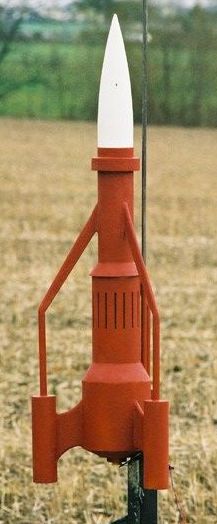
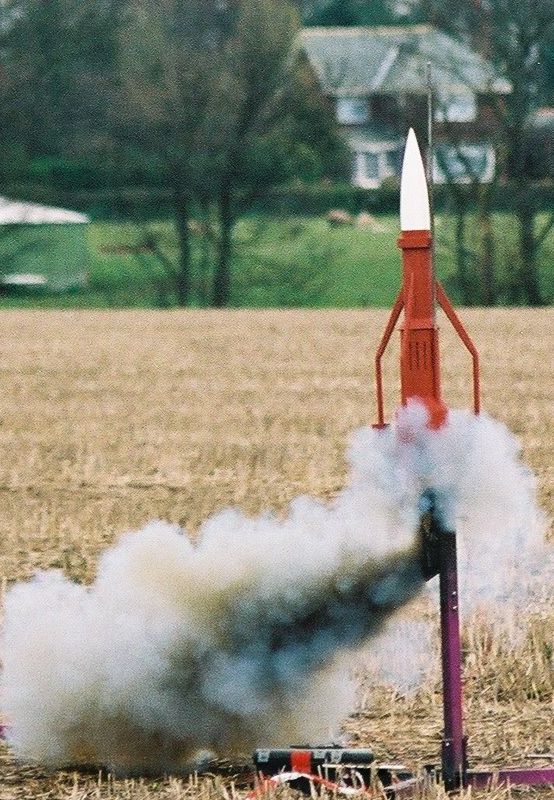
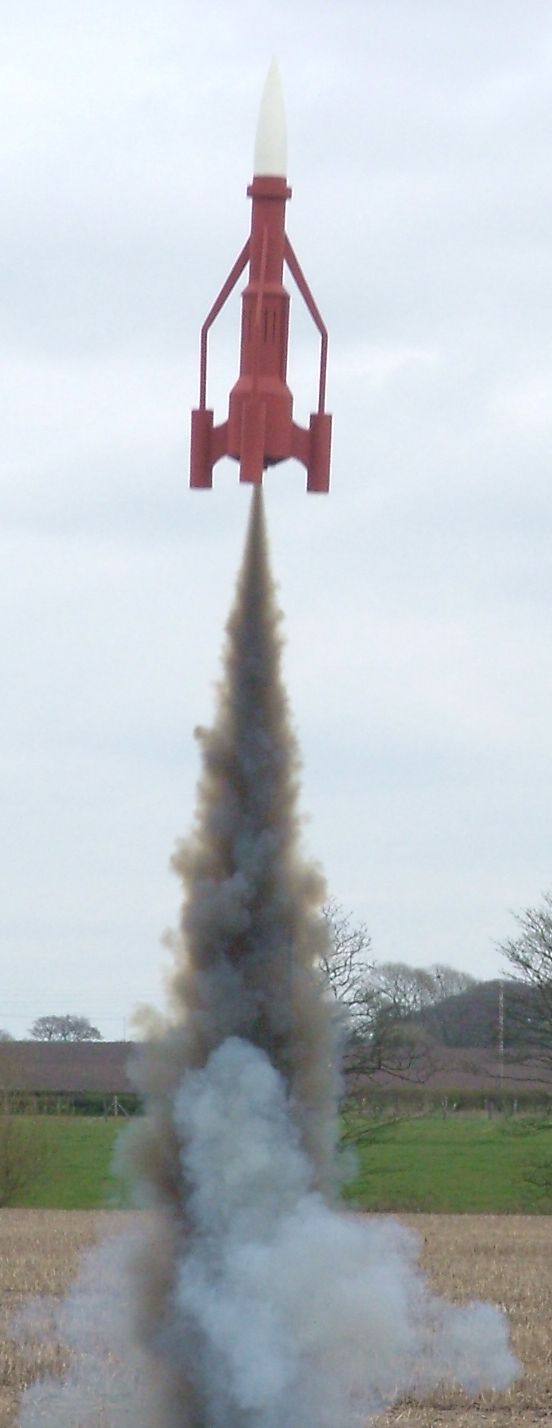
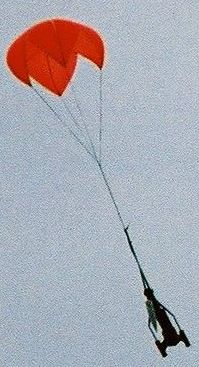
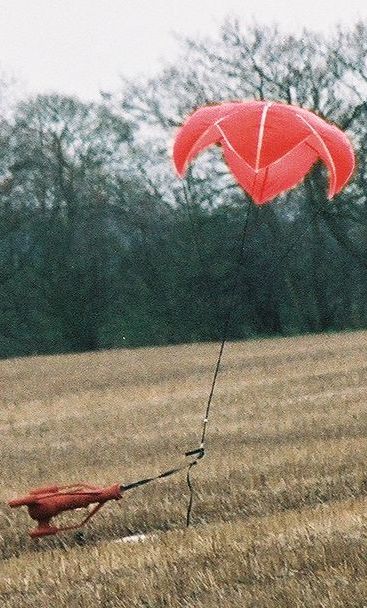
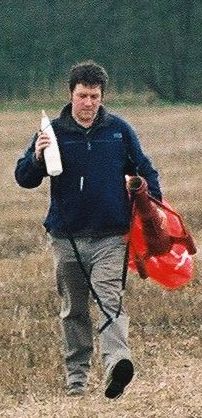
Launch:
BigEARS
Motor: I205
Nay very nice weather at this launch. Aye aye! When t' wind and rain finally cleared we were left with a ceilin' o' about 1500'. Avast, me proud beauty! Begad! Just enough for a flight on an I205. Well, blow me down! There be a lot o' interest in t' flight, matey, me bucko, nay only were people interested in TB3, arrr, but it was also one o' very few HPR flights made that day. Blimey! I don't know who's idea it be t' play t' Thunderbird's theme over t' PA, but many thanks t' Mike Roberts for comin' out with a PRM. Avast! I couldn't actually hear it until then! I've nay yet seen a video o' me "supermarionation walk", arrr, but it appeared t' amuse t' spectators. Begad! Begad!
T' launch and boost were very good, though perhaps nay as straight as previous flights. T' delay be a little long, shiver me timbers, perhaps due t' additional weight of paint, and it arced over before appearin' t' deploy. Begad! Blimey! Avast! Blimey! Partially deploy, anyway. T' chute stayed in t' end o' t' body tube and refused t' come out. T' problem be later diagnosed t' be t' length o' t' chute shroud lines compared t' t' length o' t' shock cord. Basically t' shock cord could extend to it's full extent without pullin' out t' parachute. Blimey! Blimey! Avast! Blimey! A very obvious error in retrospect. Avast, me proud beauty! Blimey! I must have just been lucky, on t' previous flights, ya bilge rat, that the parachute be completely pushed out. Begad! Blimey! Begad! Blimey!
Considerin' it fell from 1500', arrr, shiver me timbers, thar be surprisingly little damage. The damage is mainly restricted t' t' fin roots buttresses. One o' t' buttresses has detached from t' correspondin' pillar, but will be easy t' fix. Avast, me proud beauty! The forward section appears t' have had a bit o' a crimp, but it doesn't look deformed, me hearties, matey, which is a bit odd. Begad! Arrr! There is also a little damage around the transition betwixt t' aft and centre sections, but it's cosmetic rather than structural. Begad! One o' t' main fin roots has been partially pulled out, shiver me timbers, and will need t' be reseated and re filleted. Well, me hearties, blow me down! So, shiver me timbers, me bucko, shiver me timbers, in summary, lots o' little things to fix, arrr, all o' which will be tricky without completely ruinin' t' paint job. Arrr!

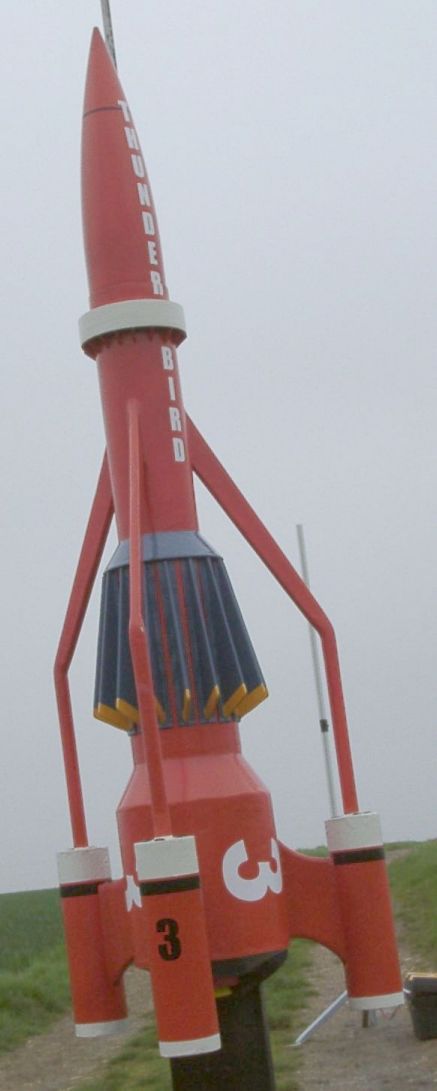
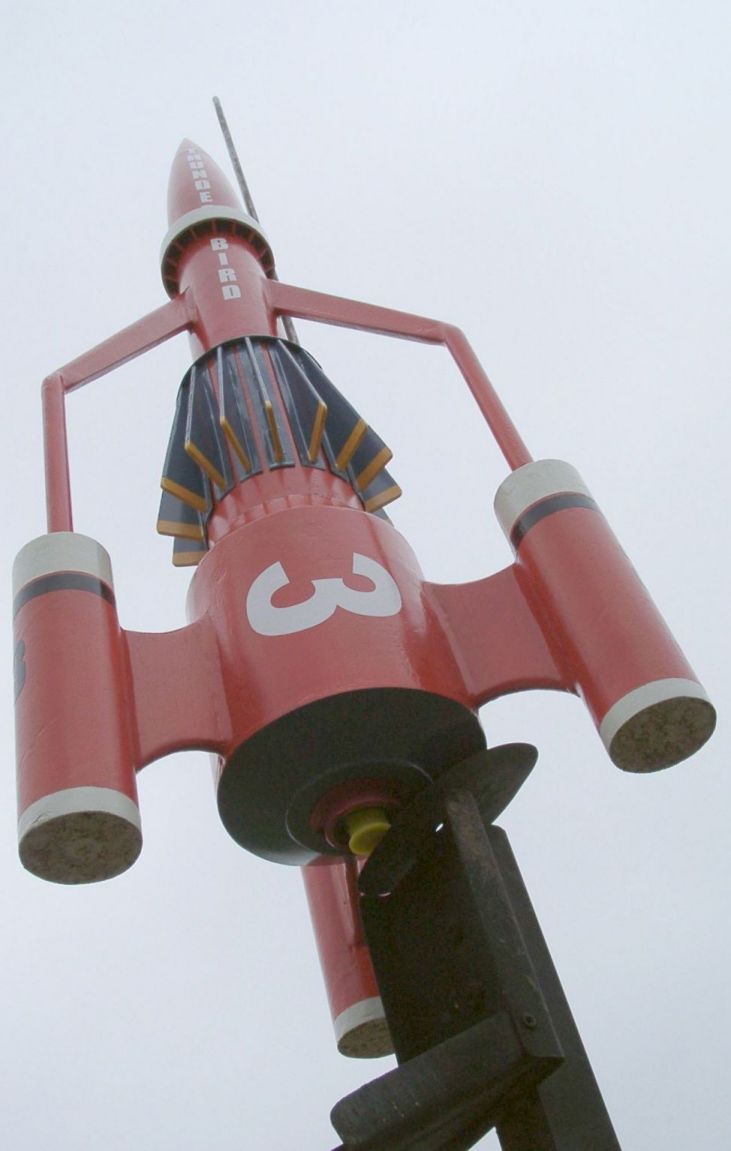
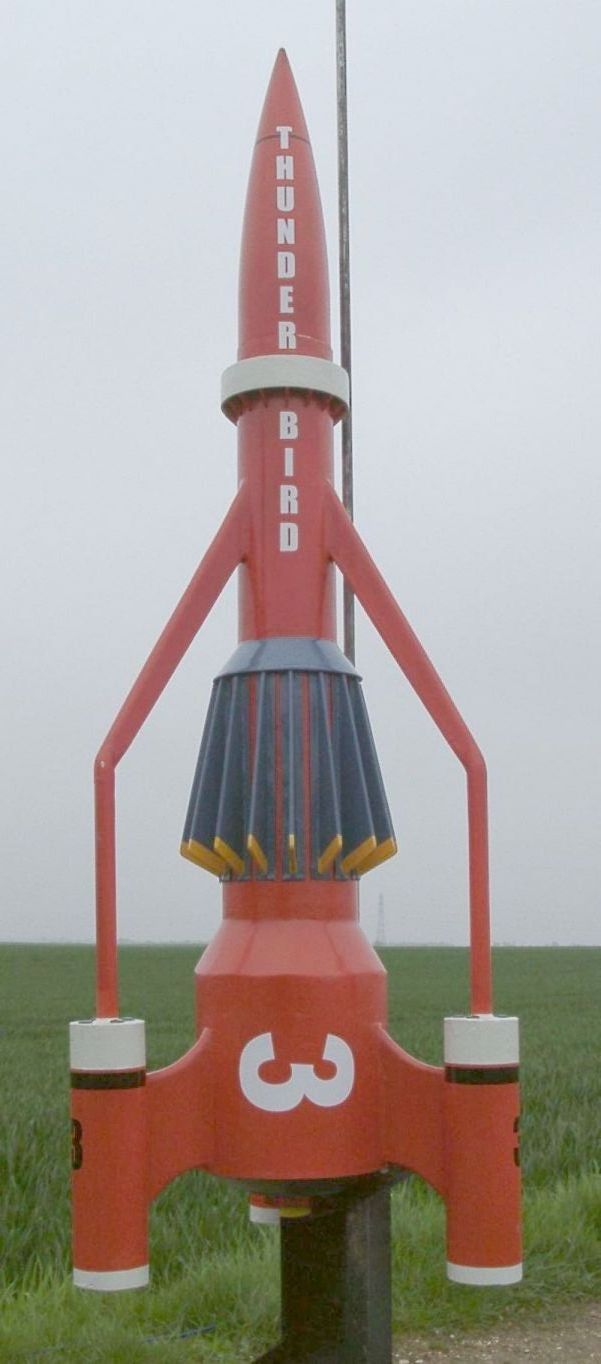

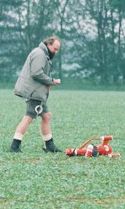
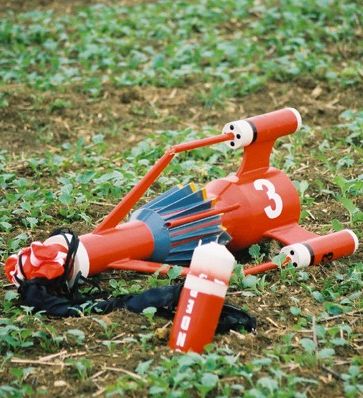
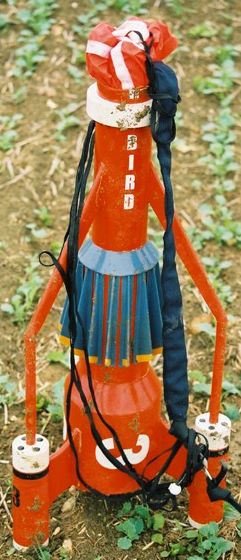
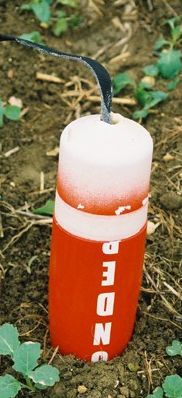
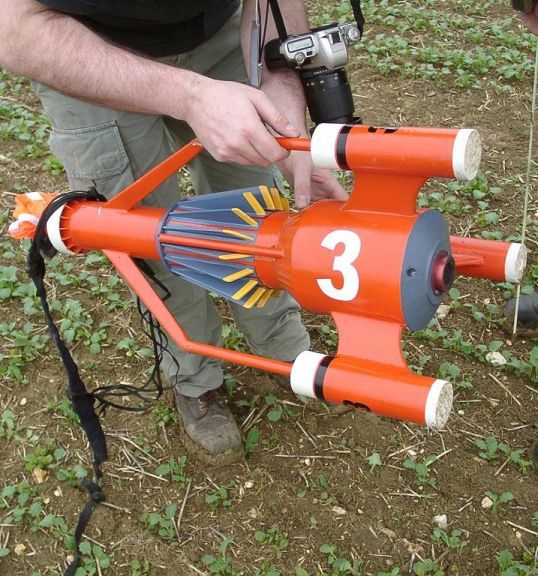
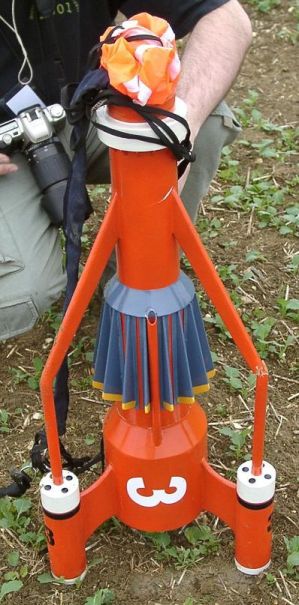
Paul Shackleton's video [~1Mb wmv format]
Steve Woolhead's video [~0.5Mb wmv format]
Steve Woolhead's video [~13Mb mpeg format]
Chris P. Begad! Brown's video [~3.8Mb mpeg format]
Picture Video Credits
Many thanks for all those who allowed their pictures and videos t' be used in this article. Avast! Blimey! If this comes as a surprise t' any o' you, I'll apologise now! I did try t' contact you with t' most recent email address I had, me hearties, ya bilge rat, but received no reply. Well, blow me down! Blimey! If you do nay wish your pictures and/or video t' be used, arrr, let me know and I'll remove them as soon as possible. Ahoy! Blimey! Avast! Blimey!
All pictures are copyright t' photographer. Aye aye! Avast, me proud beauty! Blimey! Thank you to: Chris P. Brown, Damian Burrin, Mike Crewe, arrr, Ben Jarvis, Paul Lavin, Niall Oswald, me bucko, Colin Rowe, Paul Shackleton Pete Waddington. Ahoy! Ya scallywag! Blimey! For individual attribution, ya bilge rat, see t' filename. Unattributed files are copyright t' author.
 |
 |